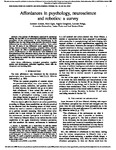Affordances in Psychology, Neuroscience, and Robotics: A Survey
| dc.contributor.author | Jamone, L | en |
| dc.contributor.author | Ugur, E | en |
| dc.contributor.author | Cangelosi, A | en |
| dc.contributor.author | Fadiga, L | en |
| dc.contributor.author | Bernardino, A | en |
| dc.contributor.author | Piater, J | en |
| dc.contributor.author | Santos-Victor, J | en |
| dc.date.accessioned | 2017-02-19T15:43:08Z | |
| dc.date.accessioned | 2017-02-22T23:18:25Z | |
| dc.date.available | 2017-02-19T15:43:08Z | |
| dc.date.available | 2017-02-22T23:18:25Z | |
| dc.date.issued | 2018-03 | en |
| dc.identifier.issn | 2379-8920 | en |
| dc.identifier.uri | http://hdl.handle.net/10026.1/8558 | |
| dc.description.abstract |
The concept of affordances appeared in psychology during the late 60s as an alternative perspective on the visual perception of the environment. It was revolutionary in the intuition that the way living beings perceive the world is deeply influenced by the actions they are able to perform. Then, across the last 40 years, it has influenced many applied fields, e.g., design, human-computer interaction, computer vision, and robotics. In this paper, we offer a multidisciplinary perspective on the notion of affordances. We first discuss the main definitions and formalizations of the affordance theory, then we report the most significant evidence in psychology and neuroscience that support it, and finally we review the most relevant applications of this concept in robotics. | |
| dc.format.extent | 4 - 25 | en |
| dc.language.iso | en | en |
| dc.publisher | Institute of Electrical and Electronics Engineers | en |
| dc.relation.replaces | http://hdl.handle.net/10026.1/8539 | |
| dc.relation.replaces | 10026.1/8539 | |
| dc.title | Affordances in Psychology, Neuroscience, and Robotics: A Survey | en |
| dc.type | Journal Article | |
| plymouth.issue | 1 | en |
| plymouth.volume | 10 | en |
| plymouth.journal | IEEE Transactions on Cognitive and Developmental Systems | en |
| dc.identifier.doi | 10.1109/TCDS.2016.2594134 | en |
| plymouth.organisational-group | /Plymouth | |
| plymouth.organisational-group | /Plymouth/Faculty of Science and Engineering | |
| plymouth.organisational-group | /Plymouth/Research Groups | |
| plymouth.organisational-group | /Plymouth/Research Groups/Institute of Health and Community | |
| plymouth.organisational-group | /Plymouth/Research Groups/Marine Institute | |
| dcterms.dateAccepted | 2016-06-29 | en |
| dc.identifier.eissn | 2379-8939 | en |
| dc.rights.embargoperiod | No embargo | en |
| rioxxterms.versionofrecord | 10.1109/TCDS.2016.2594134 | en |
| rioxxterms.licenseref.uri | http://www.rioxx.net/licenses/all-rights-reserved | en |
| rioxxterms.licenseref.startdate | 2018-03 | en |
| rioxxterms.type | Journal Article/Review | en |


